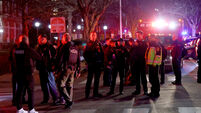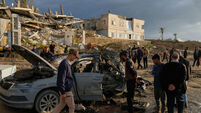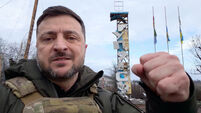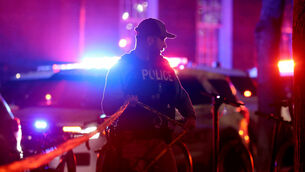Chernobyl remembered 18 years on
In all, seven million people in the former Soviet republics of Belarus, Russia and Ukraine are estimated to suffer physical or psychological effects of radiation related to the April 26, 1986, catastrophe, when reactor No 4 exploded.
An area half the size of Italy was contaminated, forcing hundreds of thousands of people to be resettled and ruining some of Europe’s most fertile agricultural land.
Hundreds of Ukrainians filled the small Chernobyl victims’ chapel in Kiev, at 1.23am (10.33pm Sunday), the exact time of the explosion. Later, they laid flowers and lit candles at a small hill where marble plates are inscribed with the names of hundreds of victims.
Nearly 1,000 mourners gathered at Kiev’s memorial to Chernobyl victims, a statue of five falling metallic swans. Some placed photos of dead relatives at its base.
“Nothing can be compared with a mother’s sorrow,” said Praskoviya Nezhyvova, clutching a photograph of her son, Viktor. She said he died of Chernobyl-related stomach cancer in 1990, aged 44.
Volodymyr Diunych, a driver who took the inadequately-equipped cleanup crews to the site, recalled watching as residents were evacuated “in an awful rush” days after the disaster.
Meanwhile, the Soviet Union’s traditional May Day celebrations went ahead in Kiev, 80 miles south of Chernobyl, only five days after the accident.
Soviet authorities withheld much information on the world’s worst nuclear accident from its people and the rest of the world. Only last year, Ukraine’s security service declassified secret files documenting malfunctions and safety violations at the plant, that caused the release of small doses of radiation from time to time long before the explosion.
Ukraine shut Chernobyl’s last working reactor in December 2000, but many problems remain.
Experts say the concrete and steel shelter that was hastily constructed over the damaged reactor needs urgent repairs, but authorities claim there are no safety threats. Meanwhile, many people, injured or displaced because of the explosion, complain about inadequate government support.
Sergei Shchvetsov, the head of Russia’s Chernobyl Union, said that 40,000 people disabled in operations to clean up the blast live in Russia and the “volume of benefits to which they are eligible is narrowing every year”.
More than 2.32 million people have received hospital treatment in Ukraine with illnesses blamed on the disaster, including 452,000 children, according to the Health Ministry.
Ukraine has registered some 4,400 deaths.
The most frequently noted Chernobyl-related diseases include thyroid and blood cancer, mental disorders and cancerous growths.
The UN said that in some areas of Belarus, thyroid cancer among children has increased more than 100- fold since the accident.














